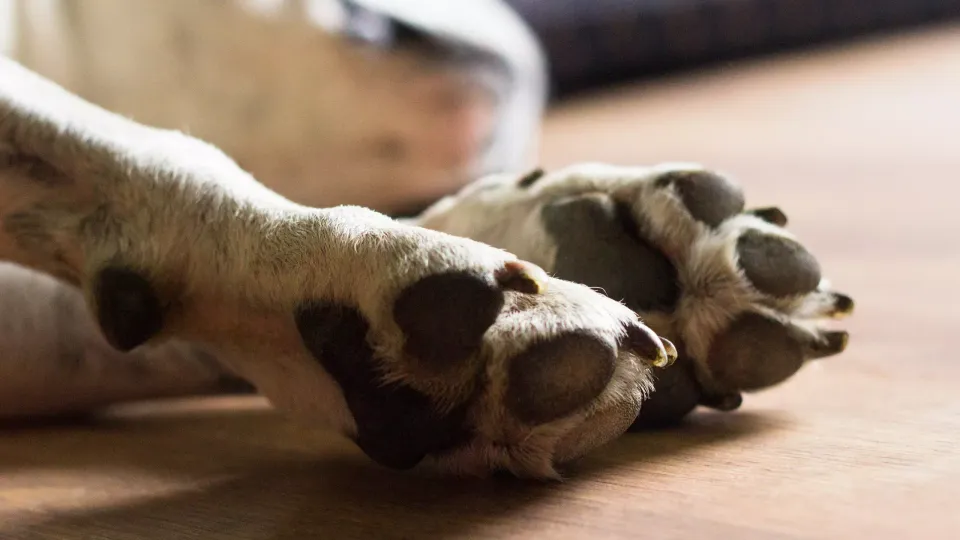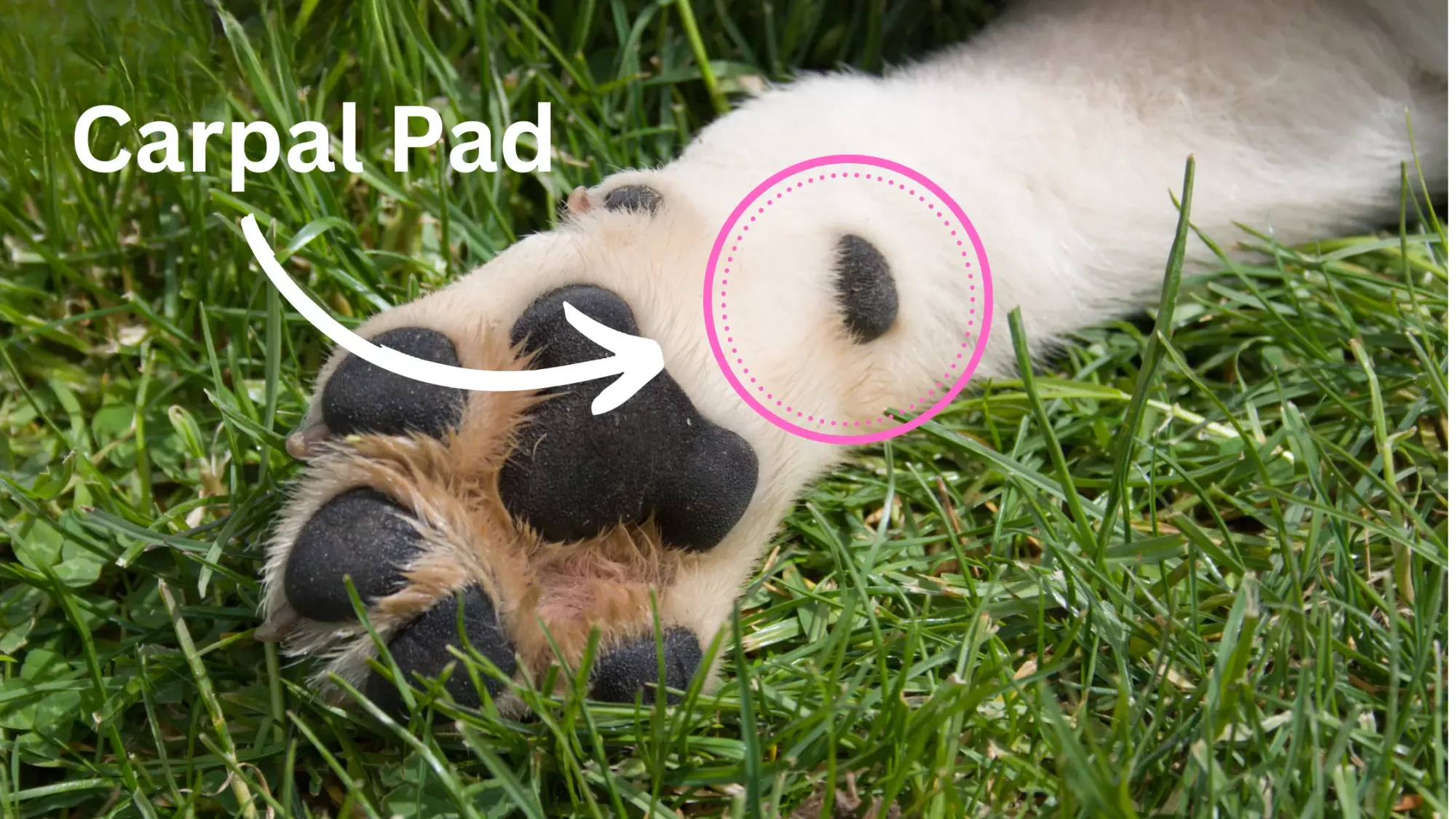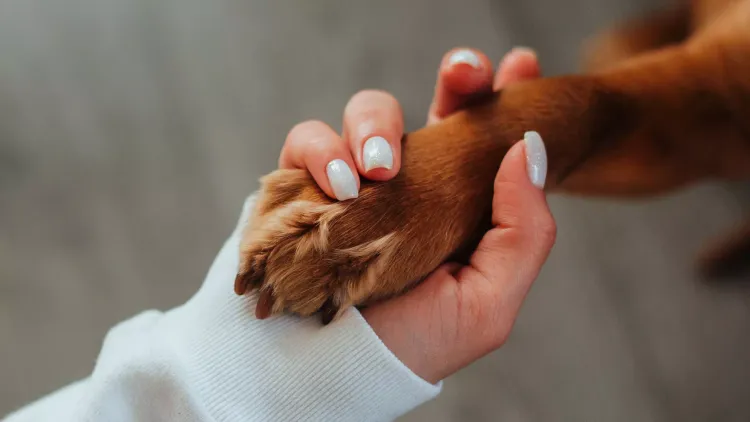What is Carpal Pad

Every dog owner is familiar with the joyous sight of their furry friend bounding across a field or playfully chasing a ball. As they move, their paws, with their soft, cushiony pads, touch the ground, providing them with the necessary grip and protection. But while most of us are well-acquainted with the main paw pads, there's another lesser-known but equally important pad on our dogs' legs: the carpal pad.
Located higher up on the leg, away from the main cluster of paw pads, the carpal pad often goes unnoticed. Yet, this small, often triangular-shaped pad plays a significant role in a dog's daily activities. Whether it's providing extra traction during high-speed chases, acting as a protective barrier against rough terrains, or aiding in braking during sudden stops, the carpal pad is a marvel of canine anatomy.

In this article, we'll embark on a journey to explore the intricacies of the carpal pad. From its functions and significance to care tips and common issues, we'll unravel the mysteries of this often-overlooked part of our beloved pets.
What is the Carpal Pad?
The carpal pad, at first glance, might seem like just another part of a dog's paw, but it holds a unique position in the canine anatomy and serves distinct purposes. To truly understand its significance, let's delve deeper into its structure, location, and evolutionary history.
- Location and Appearance: The carpal pad is situated on the anterior side of a dog's front leg, distinctly separate from the main paw pads. It's positioned proximal to the paw, aligning with the dog's wrist or carpus, which gives it its name. In terms of appearance, it's often triangular or oval-shaped and might be smaller in size compared to the primary paw pads.
- Texture and Composition: Similar to other paw pads, the carpal pad is made up of thick, fatty tissue covered by a layer of keratinized skin. This composition gives it a rough texture, which is essential for its primary functions of traction and protection. The pad's surface is designed to withstand various terrains and conditions, from hot asphalt to icy sidewalks.
- Evolutionary Significance: The presence of the carpal pad can be traced back to the wild ancestors of modern-day dogs. These pads were crucial for survival in diverse environments, from dense forests to rocky terrains. They provided additional grip and protection, ensuring that these wild canines could hunt, navigate, and protect themselves effectively.
- Variations Across Breeds: While all dogs have carpal pads, there can be slight variations in size, shape, and prominence across different breeds. For instance, breeds that are more agile and are known for their speed, like Greyhounds or Border Collies, might have more pronounced carpal pads. This is because these breeds often rely on the added traction and stability that the carpal pad provides during their swift movements.
- The Carpal Pad in Relation to Other Pads: A dog's paw typically consists of the main digital pads, a larger metacarpal pad, and the dewclaw pad (if the dog has a dewclaw). The carpal pad is separate from these and is located further up the leg. While each pad has its specific function, they all work in harmony to support the dog's movements, provide cushioning, and protect against environmental factors.
Functions of the Carpal Pad
The carpal pad, while smaller and less conspicuous than the main paw pads, serves a myriad of essential functions that contribute to a dog's overall mobility, safety, and comfort. Let's delve into the multifaceted roles of the carpal pad:
- Enhanced Traction: One of the primary functions of the carpal pad is to provide additional traction. Its rough texture ensures that dogs maintain a firm grip on various surfaces, especially during high-speed runs or sharp turns. This is particularly crucial for agile breeds that often make quick maneuvers.
- Braking Mechanism: When a dog decides to stop suddenly or slow down from a sprint, the carpal pad acts as a natural braking mechanism. It makes contact with the ground, creating friction that helps the dog decelerate safely without skidding or injuring itself.
- Protective Barrier: The carpal pad acts as a protective shield against rough or abrasive terrains. Whether it's rocky paths, thorny bushes, or hot pavements, the carpal pad offers an added layer of protection, preventing cuts, bruises, and burns.
- Stability on Uneven Ground: On uneven terrains or when climbing slopes, the carpal pad touches the ground, offering an extra point of contact. This added support ensures better weight distribution and balance, preventing slips or falls.
- Shock Absorption: Much like the other paw pads, the carpal pad also plays a role in absorbing the impact when a dog jumps or lands. This cushioning effect protects the dog's joints and bones from undue stress, especially in active breeds that love to leap and bound.
- Thermoregulation: Dogs don't sweat like humans. Instead, they pant and use their paw pads, including the carpal pad, for thermoregulation. The carpal pad can help dissipate heat, aiding in cooling the dog down during hot conditions.
- Sensory Function: While not as sensitive as the main paw pads, the carpal pad contains nerve endings. These nerve endings can detect temperature changes and surface textures, allowing the dog to adjust its movements accordingly. For instance, if a surface is too hot or too slippery, the sensory feedback from the carpal pad can prompt the dog to choose a safer path.
- Evolutionary Role: From an evolutionary perspective, the carpal pad was crucial for wild canines navigating diverse terrains. It provided the necessary grip and protection, ensuring efficient hunting, escaping from predators, and traversing challenging landscapes.
Caring for the Carpal Pad: A Detailed Guide
The carpal pad, like other parts of a dog's anatomy, requires regular attention and care to ensure its health and functionality. Proper care can prevent injuries, infections, and ensure your dog remains comfortable during its daily activities. Here's a comprehensive guide on how to care for your dog's carpal pad:
- Regular Inspection: Start by making it a habit to inspect the carpal pad regularly. Look for signs of cracks, cuts, blisters, or foreign objects like thorns or glass shards. Early detection of any issues can prevent complications and infections.
- Gentle Cleaning: After walks or outdoor activities, clean the carpal pad using lukewarm water and a mild dog-friendly soap. This will remove dirt, debris, and potential allergens. Ensure you rinse thoroughly and pat dry with a soft towel.
- Moisturization: Just like human skin, a dog's carpal pad can become dry and cracked, especially in harsh weather conditions. Consider using a dog-specific paw balm or wax to moisturize and protect the pad. Avoid using human lotions as they might contain ingredients harmful to dogs.
- Protection from Extreme Temperatures: In hot weather, avoid walking your dog on hot asphalt or sand, which can burn the carpal pad. In cold and snowy conditions, ice and road salts can be harmful. Consider using dog booties or protective waxes to shield the pads from extreme temperatures.
- Trim Excess Hair: Some dog breeds have hair that grows between and around their paw pads, including the carpal pad. Regularly trim this hair to prevent matting, which can lead to discomfort and trap dirt and moisture.
- Address Injuries Promptly: If you notice any injury, even a minor one, address it immediately. Clean the wound, apply an antiseptic, and if necessary, consult your veterinarian. Keeping a pet first aid kit handy can be beneficial for such situations.
- Avoid Harsh Chemicals: When cleaning your home or yard, be mindful of the cleaning agents and chemicals you use. Some can be harmful or irritating to your dog's pads. Always rinse your dog's paws after exposure to such agents.
- Provide Proper Nutrition: A balanced diet plays a role in the health of your dog's skin, including the carpal pad. Ensure your dog receives all the necessary nutrients for healthy skin and pads. Omega fatty acids, in particular, can promote skin health.
- Regular Vet Check-ups: During routine vet visits, ask the veterinarian to inspect the carpal pad. They can provide specific care recommendations tailored to your dog's breed, age, and activity level.
- Training and Familiarization: Train your dog to be comfortable with you touching and inspecting its paws. Positive reinforcement, treats, and gentle handling can make the process smoother for both of you.
Common Issues and Concerns with the Carpal Pad
The carpal pad, while resilient, is not immune to various issues that can arise due to environmental factors, injuries, or underlying health conditions. Awareness of these common concerns can help dog owners take timely action and ensure the well-being of their furry companions. Here's a detailed look at some prevalent issues and concerns associated with the carpal pad:
- Cuts and Abrasions: Given its location and function, the carpal pad is prone to cuts, especially when dogs walk on rough or sharp terrains. Small cuts might heal on their own, but deeper wounds require cleaning and possibly veterinary attention.
- Dryness and Cracking: Just like other paw pads, the carpal pad can become excessively dry, leading to cracks. This can be due to environmental factors, such as cold weather, or underlying skin conditions.
- Burns: Walking on hot surfaces, especially asphalt during summer, can lead to burns on the carpal pad. It's essential to test the ground's temperature with your hand before letting your dog walk on it.
- Frostbite: In extremely cold conditions, especially when there's snow and ice, the carpal pad can suffer from frostbite. The pad might appear pale or gray and feel cold to the touch.
- Allergic Reactions: Dogs can develop allergic reactions to certain substances they come in contact with, leading to itching, redness, and swelling of the carpal pad.
- Infections: Open wounds, if not treated promptly, can become infected. Signs of infection include pus, increased redness, swelling, and a foul odor.
- Tumors and Growths: While rare, tumors, both benign and malignant, can develop on the carpal pad. Any unusual growth or lump should be checked by a veterinarian.
- Foreign Body Injuries: Thorns, glass shards, or other foreign objects can get embedded in the carpal pad, causing pain and discomfort. It's crucial to remove such objects carefully and clean the area.
- Calluses: Repeated friction or pressure on the carpal pad can lead to the formation of calluses. While they offer protection, excessively thick calluses can become painful.
- Autoimmune Disorders: Certain autoimmune disorders can affect a dog's skin, including the carpal pad. Conditions like pemphigus can lead to blisters and sores on the pad.
- Parasitic Infections: Ticks, fleas, and mites can latch onto the carpal pad, leading to itching, inflammation, and potential secondary infections.
Conclusion
The carpal pad, though small and often overlooked, plays a crucial role in a dog's anatomy. As responsible dog owners, it's essential to understand its functions and ensure it's well taken care of. Whether your furry friend is a city dweller or a country explorer, their carpal pads are hard at work, providing traction, protection, and much more. So, the next time you're giving your dog a belly rub or a paw massage, don't forget to show some love to their carpal pads too!

